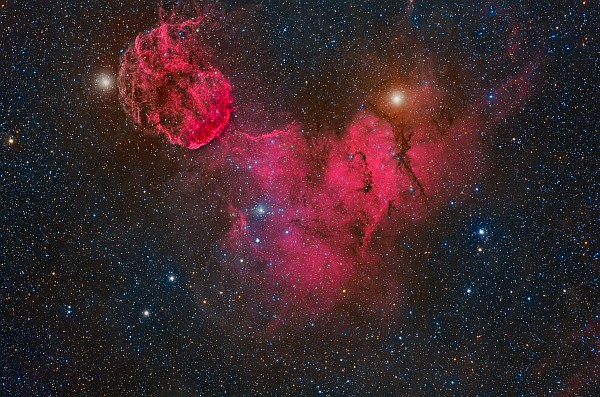Sharpless 249 and IC 443, the Jellyfish Nebula |
 |
|
The larger nebula framed in this widefield image is emission nebula Sharpless 249, the 248th entry in a catalog of HII (ionized hydrogen) objects created by Stewart Sharpless in 1959.
Like most emission nebulae, Sharpless 249 is a cloud of gas glowing by the ionizing radiation of hot, nearby stars or stars embedded within and possibly born from the nebula.
The wispy oval nebula to the upper left of Sharpless 249 is IC443 (also cataloged as Sharpless 248). Unlike Sharpless 249, IC443 is not an emission nebula, but a supernova remnant! Sometime between 30,000 and 35,000 years ago, a supernova went off in the constellation Gemini. IC 443 is the expanding shell of the gas and dust blown off by that supernova. It is glowing both by the radiation from a pulsar located approximately at the center of the blast area as well as ionization of gases in the interstellar medium caused by the shock front of the still-expanding supernova remnant. The side of IC443 adjoining Sharpless 249 is noticeably brighter in this image, hinting (to me at least) that the shock front of the supernova is colliding with the slightly denser gases of Sharpless 249. IC 443 is popularly known as the Jellyfish Nebula. Most images of this object (including my prior attempt from 2007, linked below) are usually displayed rotated 180 degrees from the way I am depicting it, and in that mode the supernova remnant does resemble its namesake. In processing this image, I noticed that in this orientation IC443 looks more symmetrical, almost torus-shaped. I wonder if the apparent asymmetry is due to the one side being brighter by virtue of that side ramming into the material of its neighbor. |
| Constellation: Gemini |
| When Visible: December - May |
| Distance: 5,000 light-years |
| Date: February 2013 |
| Location: Rancho Hidalgo, Animas, NM |
| Exposure Details:
H-alpha: 17 x 30 Minutes Binned 1x1 R: 7 x 10 Minutes Binned 1x1 G: 7 x 10 Minutes Binned 1x1 B: 7 x 10 Minutes Binned 1x1 12 Hours total exposure time |
| Equipment Used: Takahashi FSQ-106N on an Astro-Physics AP1200GTO mount. SBIG STL-11000 camera with 5-position filter wheel and Astrodon filters. Robofocus focuser. Externally guided with an SBIG Remote Guide Head on a Borg 45ED refractor. |
| Acquisition Software : MaximDL, TheSky6, CCDAutopilot |
| Processing Software: MaximDL, Photoshop CS5, HLVG, Astro Actions by Noel Carboni, IrFanView |
| An H-alpha-only version taken from our backyard in Ohio back in 2007 can be seen here. 5 x 30 Minutes H-alpha exposures binned 1x1. Takahashi FSQ-106N on a Takahashi EM200 Temma-PC mount. SBIG STL-6303 camera with 5-position filter wheel and Astrodon narrowband filters. Externally guided with an SBIG Remote Guide Head on a Borg 76ED refractor. |
